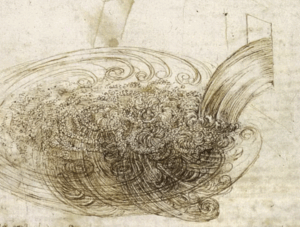Ryan Yu | 7/18/25
What do ship propulsion systems, hydroelectric dams, prosthetic blood pumps, and industrial mixers have in common? Each system involves a solid structure interacting with fluid! It’s so important to understand these interactions that a whole field, called Computational Fluid Dynamics, is dedicated to exploring it. Fluid drag research in particular focuses on shear stress, the force of a fluid against the structure that can slow down or damage equipment over time. One important factor is fluid viscosity, which is an intrinsic value of how “thickly” the liquid flows. Imagine starting a ship propellor in fresh cement–the propellor’s going to break pretty fast! Another important factor is the surface area of the structure, which accounts for the degree of interaction. It took a long time for scientists to start to piece together observations into hard and fast physics rules! In this story, there are a few especially notable protagonists:
Leonardo da Vinci
Da Vinci made some of the first recorded observations of fluid resistance and flow patterns from rotating bodies. In his journals, he drew sketches of water flow around rotating paddles. They resemble our modern understanding of turbulence and eddy formation.

This sketch from Da Vinci’s diary is widely recognized as the first EVER visualization of turbulent flow.
Isaac Newton
In Principia Mathematica, Newton further developed the theory about resistance from fluids. He was the first to prove a proportion between fluid drag and velocity squared. To achieve this, he ignored viscosity, which was a precedent scientists would follow even as theories became more precise. For the next two hundred years, no one could prove a mathematical relationship between viscosity and fluid drag, and scientists simply assumed ideal fluid flow, such as in the Euler equations.
Newton’s Proposition XXIX. Problem VI:
Supposing that a body oscillating in a cycloid is resisted in a duplicate
ratio of the velocity: to find the resistance in each place.
Claude-Louis Navier & George Stokes
The field took a big leap forward in the mid 1800’s, when French mathematician Navier, and Irish mathematician Stokes, provided the Navier-Stokes equations in 1921. This was groundbreaking partly because it defined several types of drag, including friction drag and pressure drag. They proved that viscosity was directly related to the first, and indirectly related to the latter.

I used this equation in COMSOL to model fluid drag in Ampere’s Rotating Conductors.
Click here to learn about Galvanic cells!